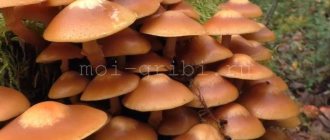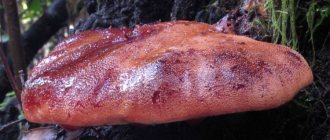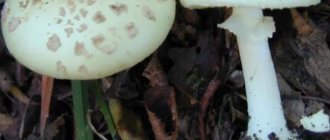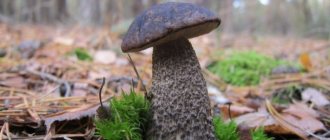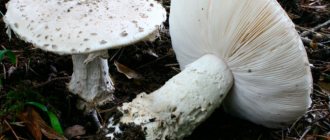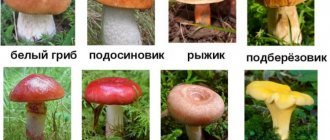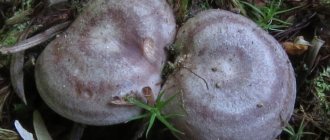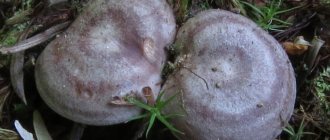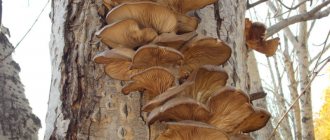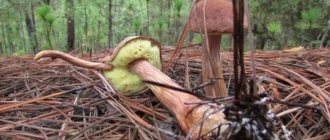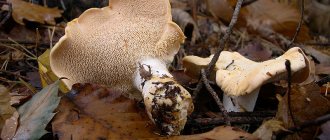The honey fungus is an edible mushroom, a close relative of the widely known and beloved autumn honey mushroom. Belongs to the genus of honey fungus (Armillaria) of the Physalacriaceae family, lamellar group.
The autumn honey fungus (Armillaria mellea Fr.) is a real headache for mycologists (mushroom specialists). The fact is that the external signs of mushrooms within a given species can vary greatly, however, until recently, their owners were considered one species. From time to time, after genetic research, certain representatives of the autumn honey fungus species are isolated into separate independent species.
The thick-legged honey agaric also previously belonged to the autumn honey fungus species, although it differs from it in both its place of growth and appearance.
The mushroom has dense, white flesh. As for the taste and aroma of the autumn honey mushroom, opinions vary: some believe that the smell of the mushroom is weak, sweetish, unpleasant, reminiscent of cheese, and the taste is astringent. Others note a pleasant mushroom aroma and taste and, when collecting, give preference to this particular species. All that remains is to collect these mushrooms, prepare a dish from them and try them to form your own opinion.
The mushroom is universal, suitable for all types of culinary processing. There are many recipes for thick-legged honey mushroom. Showed itself well in preparations for the winter. However, it requires mandatory additional pre-processing.
But the benefits of the honey mushroom are far from limited to this. The mushroom is not only tasty, but thanks to its rich set of vitamins, macro- and microelements, and other biologically active substances in its composition, it is a valuable food product and is used for various hypo- and vitamin deficiencies, to compensate for the lack of certain substances in the body.
Honey fungus also has medicinal properties and is used to treat a number of diseases, including as an inhibitory agent for sarcoma-180 and Ehrlich carcinoma. For prevention purposes, the mushroom is recommended to stabilize the general condition of the body, as an immunomodulator and a universal tonic.
Based on such a wide range of applications, honey mushroom is one of the most popular mushrooms, harvested on an industrial scale.
Thick-legged honey fungus. Latin name : Armillaria gallica.
Synonyms : Armillaria lutea, Armillaria bulbosa.
Thick-legged honey fungus. Another name : bulbous honey fungus (swollen).
Types of these mushrooms, appearance
The thick-legged honey fungus has a certain number of features with which it can be easily distinguished from other species:
- The cap of this mushroom is dome-shaped and reaches 10 cm in diameter. Small scales radiate from its center, which darken over time and descend towards the leg. As for color, you can find brown, pink and brown thick-legged honey mushrooms here.
- The flesh of the mushroom is light in color and smells very much like cheese.
- The leg of this species has a cylindrical shape, gradually widening downward. It grows up to 9 cm in height, and is usually 2 cm in girth.
Did you know? American scientists have determined that in one of the oak forests in their country there is a mycelium of one giant living organism more than 2,500 years old.
This mushroom was given the name “Michigan thick-legged honey fungus.” It should be noted that the genus honey mushrooms has several species. In addition to thick-legged mushrooms, this also includes winter, summer, autumn and spring honey mushrooms. Mushroom pickers often come across meadow, spruce, field and forest mushrooms of this genus.
Botanical description
hat
The cap of the thick honey mushroom is rounded. In young mushrooms, it is hemispherical, broadly conical, with a tucked edge; as it grows, it opens up and becomes convex-prostrate with a drooping edge. The edges are slightly ribbed, slightly woolly, with yellowish flaky remains of the private spathe.
The color of the skin of the honey mushroom, depending on the place of growth, varies from almost white, yellowish-grayish, pink to dark brown, brown. The color is sometimes whitish along the edges
When young, the cap is evenly covered with numerous small grayish-brown or dark brown conical fibrous scales, which in older specimens are preserved mainly in the center. Diameter: 2.5-12 to 17 cm.
Hymenophore
The hymenophore of the honey fungus (lower part of the cap) - the plates are quite frequent, narrow, straight or arched, with a smooth or jagged edge, descending onto the stalk. At first they are whitish, then as the mushroom grows they become darker, with a brownish tint in older mushrooms.
The spores are elliptical, almond-shaped. Color: whitish. Size: 7.5-2 × 5-6.5 microns. Color of honey fungus spore powder: white.
Leg
The stalk is rounded, roughly longitudinally fibrous, almost grooved, noticeably thickened at the base. It has a whitish or yellowish fibrous or membranous ring, which is torn in a star-shaped manner, often covered along the edge with brownish scales. Below the ring are yellowish remains of the bedspread.
The color is lighter than the caps: above the ring it is whitish, chrome-yellow, below it is brownish, at the base it is often with a gray tint.
In the lower part, the leg of the thick-footed honey agaric is covered with numerous woolly scales. Color: yellow, grayish-yellow.
Leg height: 4-8, up to 12 cm, diameter: 0.5-2, up to 2.5 cm.
Pulp
The flesh of the cap is thin, dense, the legs are fibrous and tough. Color: light, whitish. Does not change when cut. Smell: sweetish, reminiscent of Camembert cheese. Taste: pleasant, with a slight bitterness.
Where, when and how does it grow
The honey fungus is a parasitic species. It usually settles on fallen stumps. It can also often be found on beech, oak or spruce, less often on ash and fir.
Representatives of this species grow in temperate climates, but they can also be found in the Urals and the Far East. The best time to collect thick-legged honey mushrooms is from August to mid-September.
How to process
After collection, honey fungus should be processed as quickly as possible. However, before the main culinary processing, additional preliminary preparation is required, which consists of the following:
- The mushrooms are sorted out and carefully examined, removing forest debris and discarding suspicious, wormy and rotten specimens.
- In mature and old specimens, the legs are removed.
- One of the useful qualities of thick-legged honey mushrooms is that they do not need to be pre-soaked. It is enough to rinse thoroughly several times, changing the water each time.
The exception is drying. The mushrooms intended for it are not washed, but only cleaned of debris with a sponge or toothbrush.
- Due to certain substances in the chemical composition, honey mushroom in its raw form has a slightly pungent taste. Eating raw or insufficiently tested mushrooms can cause mild poisoning, which is expressed in painful sensations in the digestive tract. During boiling, toxins are destroyed and the mushrooms can be eaten. This requirement applies to all types of products, with the exception of drying and some types of freezing.
- Many people are interested in how to cook thick-legged honey fungus. For 1 kg. prepared mushrooms will require 2 liters. water and 1.5 tbsp. salt. Place mushrooms in salted boiling water, bring to a boil and cook over medium heat for 20 minutes. (for marinating 10-15 minutes) Place the finished honey mushrooms in a colander and allow the water to drain.
Important! The information presented in the material is for informational purposes only. Before use, be sure to consult a specialist.
Application
Due to the high content of vitamins and beneficial macroelements, thick-legged honey mushrooms are very widely used both in cooking and in medicine. So, thanks to this product, you can not only diversify your diet with delicious dishes, but also even improve your body’s health and protect it from various infections.
In cooking
As for cooking, various types of dishes can be prepared from thick-legged mushrooms. These mushrooms are pickled, fried, boiled and used for pickling. Also, since this product contains a lot of protein and vitamins, it will not be superfluous in the diet of people who adhere to a vegetarian diet.
In medicine
Thick-legged honey mushrooms are often used as one of the means of fungotherapy (mushroom treatment). They are used in the form of various tinctures, powders and, of course, fresh. With the help of this type of honey mushroom, you can cleanse the body of toxins, improve intestinal function, and also provide the body with necessary vitamins and minerals.
How to store
Honey fungus is a universal mushroom, thanks to its dense pulp it is suitable for all types of preparations: The least troublesome way to store honey mushrooms for use out of season is drying, in which there is no need to pre-wash and boil the mushrooms.
For this type of preparation, it is better to give preference to young specimens. To ensure that the mushrooms are dried evenly, fruiting bodies of the same size are selected. Cleaned of debris, prepared honey mushrooms are strung on a thread and dried in the open air. It is also possible to dry them in the oven at a temperature of 50°C, remembering to turn the mushrooms over and change the position of the baking sheet.
Ready, dried honey mushrooms are stored in glass jars closed with a plastic lid in a dry, well-ventilated area. Since mushrooms tend to absorb foreign odors, you should make sure that there are no strong-smelling products or substances nearby. Before use, honey mushrooms are soaked.
Another simple way to preserve this species for the winter is freezing, for which both fresh and boiled mushrooms are suitable. At the same time, all the beneficial properties of thick-legged mushrooms are preserved. Fresh mushrooms should first be washed and dried. Frozen boiled thick-legged honey mushrooms are a semi-finished product, ready for basic culinary processing.
Marinated thick-legged honey mushrooms are incredibly tasty. Some mushroom gourmets prefer this type of mushroom for pickling. Even the harsh legs of pickled mushrooms are particularly attractive, and the marinade gives the preparation a unique piquant taste and aroma. Pickled mushrooms can be preserved.
However, you should note that only the hot method is suitable for salting and pickling, i.e. Mushrooms must be boiled first. When used dry or cold, honey fungus is harmful and can cause poisoning.
How to distinguish edible from inedible
Thick-legged honey mushrooms have their false counterparts. Some of them are also edible, and some are quite poisonous. The main ones are:
- False foam or false foam is gray-yellow. In shape it looks almost the same as the thick-legged honey mushroom. However, this double is very poisonous. It is distinguished from an edible mushroom by a yellow cap with a brown tint, and a hollow, light-colored stem inside.
- Fleecy scale. The stem of this mushroom is quite large, but, unlike the thick-legged honey mushroom, it tapers downward. There are a lot of brown scales on the cap.
- The honey fungus is dark. This edible mushroom is very similar to the thick-legged honey mushroom, but differs from it in the absence of a cheese smell and a decrease in the number of scales closer to the center of the cap.
- Autumn honey fungus. This type of fungus is found on both living and rotten wood. It has a rounded cap that reaches 15 cm in diameter. It is edible, but is very rarely used in cooking.
Similar species and false look-alikes
During a quiet hunt, the ability to recognize each individual type of mushroom and distinguish it from similar edible species is of great importance. But the most important thing is to learn to distinguish it from inedible and poisonous mushrooms that are similar in appearance, which can harm not only health, but sometimes even human life. How to distinguish thick-legged honey fungus?
Similar edible species
Autumn honey fungus
Since the thick-legged honey fungus previously belonged to the species of autumn honey fungus (Armillaria mellea) from the genus Armillaria, therefore, it has the greatest external resemblance to it. A distinctive feature is that the autumn honey fungus grows most often on living trees and is a parasite. Externally, the thick-legged honey fungus is distinguished by a pronounced scaly cap even in adulthood, a thick leg swollen at the base and a special “cobwebby” private blanket.
Bulbous honey fungus
A species very close to the thick-footed honey mushroom and difficult to distinguish is the bulbous or gray honey mushroom (Armillaria cepistipes), also belonging to the genus Armillaria. Distinctive features of this species: rather quickly disappearing scales in the center of the cap, irregular rupture of the ring (the honey agaric has a star-shaped appearance), faint remains of the veil on the stem, and a fragrant, pleasant mushroom aroma.
Common scalyfoot
Together with the autumn and thick-legged honey fungus, the common scaly mushroom (Pholiota squarrosa), belonging to the genus Pholiota of the Strophariaceae family, is sometimes collected. Although some sources mention the mushroom as inedible, other authors note its pleasant taste, although with some bitterness.
Honey fungus brick-red
Of the species similar to the thick-legged honey agaric, the conditionally edible brick-red honey agaric (Hypholoma lateritium), which belongs to the genus Hypholoma of the Strophariaceae family, should also be distinguished. Some sources classify this species as inedible. Others believe that although the mushroom has a bitter taste, after boiling for 15-20 minutes in salted water and rinsing several times and squeezing out the caps, it is suitable for preparing various dishes.
Poisonous doubles
Unfortunately, there is false honey fungus, which, if eaten, can cause serious harm to health. This is the sulfur-yellow honey fungus (Hypholoma fasciculare) from the genus Hypholoma of the Strophariaceae family. The mushroom is poisonous and, when eaten, causes poisoning, which leads to dehydration and problems with the heart and nervous systems.
This species can be distinguished from thick-legged honey mushrooms primarily by its bright sulfur-yellow, yellow-brown cap and leg and yellowish-green plates. The taste of the sulfur-yellow honey fungus is bitter and disgusting. The smell is unpleasant.
Attention! If any ailments occur a few hours after eating mushrooms, you should immediately contact a medical facility for help.
Mushroom picking season
Season and characteristics of collection Strophariaceae appear in Russian forests already in the second half of spring, because their favorite habitat is rotten and rotting wood. It is capable of retaining spring moisture for a long time and warming up faster than the soil. Mushrooms begin to bear fruit en masse in the second decade of June. The mushroom season lasts until mid-September, and in warmer climates until mid-autumn. Honey mushrooms produce crops in periods (waves), each of which lasts from 2 to 3 weeks. The second wave is considered the most abundant, and during the season you can harvest 3-4 times.
Thick-legged honey fungus.
Most mushrooms can be seen in difficult wetlands on the trunks of old alder and birch trees, as well as mossy stumps in places where trees were cut down long ago, clearings and forest edges. They often grow in forests that are more than 30 years old (there are more damaged trunks and dead wood there). Experienced mushroom pickers advise collecting strophariaceae in the morning, because they tolerate transportation better and are stored longer in unprocessed form (but no more than 4-6 hours). A wicker basket made of wicker is suitable as a container for harvesting, in which the found specimens will breathe and will not deteriorate.
Since honey mushrooms grow in families (large groups), you can quickly collect a whole basket of harvest. Mushrooms are cut with a knife, being careful not to damage their mycelium. At the same time, pay attention to the appearance of the strophariaceae, their color and smell. Honey mushrooms grow up in families. It is better to collect young specimens.
They are suitable for pickling, frying, boiling and freezing and have good taste. Large caps are cut off from old mushrooms and pickled. Darkened legs are left on the stump or trunk, because they become hard and tough over time. Some mushroom pickers also collect the stems, from which they make caviar. Summer mushrooms quickly accumulate toxic substances, so you should not collect those that grow near roads and railways, landfills and near factories. The distance from highways and factories to trees and stumps with mushrooms must be at least 1 km.
Interesting read: Beneficial properties and uses of birch chaga mushroom
Chemical composition of the mushroom
Honey mushrooms contain a high water content (up to 90% on average), which ensures their low calorie content. The remaining 10% comes from proteins (4%), fiber (2%), minerals (1.5%), carbohydrates (1.5%) and fats (1%). The nutritional value of the mushroom - per 100 g of product in grams - is as follows: dietary fiber - 5.1; proteins – 2.2; fats – 1.2; carbohydrates – 0.5; disaccharides and monosaccharides – 0.5; ash – 0.5. The chemical composition of honey mushrooms includes essential amino acids and organic acids, antioxidants, and microelements. These include: vitamins A, B, C, E; potassium – 400 mg per 100 g; iron; magnesium; calcium; phosphorus; sodium and others.
Where do honey mushrooms grow?
Hot salting of autumn thick-legged mushrooms
Thick-legged mushrooms are not only pickled, but also salted. They are equally tasty in all cooking options. With the hot method, the mushrooms are boiled and then pickled. Required Products:
- 1 kg thick-legged mushrooms;
- 3 tbsp. l. salt;
- 3-4 stalks of dill;
- 3 bay leaves;
- 3 pcs. clove buds;
- peppercorns 6 pcs.
After the boiled mushrooms have cooled, several layers of spices and honey mushrooms are formed in the container. There must be salt on top. The resulting mass is covered with a clean cloth, a plate is placed and a weight is placed on it. The container should be kept cool, the fabric should be changed periodically so that it does not become sour from the brine released. The dish will be ready in 25-30 days.
Thick-legged honey fungus.
How to grow thick-legged mushrooms
The honey fungus is a wood-destroying organism, and therefore its cultivation is somewhat different from other forest counterparts. It is best to purchase mycelium or mycelium in a specialized store. You can grow it in two ways:
- on plant residues;
- on rotten wood or blocks.
The first option is quite simple, and this method can be used even when living in an apartment.
Collected thick-legged honey mushrooms.
To do this you will need:
- Place a homogeneous or combined substrate in a container and pour boiling water over it. For these purposes, you can use hay, straw or sawdust, individually or in a mixture.
- The entire composition is cooled to room temperature.
- Then decant, squeeze well and mix with mycelium. The proportions are indicated on the manufacturer's packaging, but for 100 g you will need about 40 kg of wet substrate.
- The mixture is placed in a plastic bag (its walls should be transparent). After pressing a little, you need to tie it. Make cuts along the entire surface to allow air exchange.
- This mushroom block can be placed in any convenient place. It will be best if you hang it. This can be done indoors, in the garden or on the balcony.
- Lighting is not required for mushrooms; germination period is a month. The composition will first fluff up, turn white or turn a little yellow, and then become a fairly dense block.
- After another 2 weeks, small rudiments of mushrooms will appear; light will be required here.
- In places where fruiting bodies are found, cuts are made on the film. Mushrooms will produce a harvest for up to three weeks, but the largest harvest will occur in the first two.
The second option for growing on wood is significantly different from the previous one. To do this you need:
- Soak the beams and logs prepared for growing mushrooms for 7 days. Their length can be up to 40 cm, and their diameter up to 25 cm. If the workpieces are freshly sawn, then it is enough to keep them in water for 2 days or not soak them at all.
- Holes are drilled in the prepared wood, mycelium is introduced into them and covered with tape or tape. Then they need to be covered (use straw, cotton wool, paper or other materials).
- The mycelium will grow overgrown for up to six months, and the temperature must be maintained from +7 to +27 degrees Celsius.
- Place the logs in a ventilated place; a shady garden or a room with good ventilation is suitable.
- The harvest can be obtained three times a year - twice in spring and autumn, and also in summer, if the mushrooms like the conditions.
Some mycelium manufacturers may give separate recommendations; these are usually indicated on the packaging.
Interesting read: Where to look for the valui mushroom and when to collect it
Types of mushrooms
There are several species that differ in time and place of growth, as well as taste and appearance.
Autumn honey mushrooms (real) (Armillaria mellea)
Autumn honey mushrooms (Armillaria mellea)
Groups of autumn or true honey mushrooms can be found in late summer and early autumn on stumps and living trees, most often on birch, less often on aspens, maples and other deciduous trees.
This most delicious and aromatic species is quite large and is characterized by a rounded cap with a diameter of 5–12 cm, initially convex and then wide, which becomes smooth, prostrate, and brown in color with age. The young skin is light brown and as if sprinkled with dark scaly crumbs.
The leg is slender, up to 10 cm high, with a typical white ring, the color is light cream at the top and darker at the base. The plates are white, the flesh has a pleasant sourish, slightly tart taste.
Summer honey mushrooms (Kuehneromyces mutabilis)
Summer honey mushrooms (Kuehneromyces mutabilis)
Early small mushrooms with an orange-brown cap and a noticeable watery area in the center appear on trees from the end of May until late autumn. The cap, up to 5 cm in diameter, opens over time and sheds the lower cover. The leg is thin, hollow, up to 6 cm high with a dark ring.
Mushrooms grow together in colonies and sit tightly on damaged wood of deciduous trees. The plates are creamy-brown, the flesh is brownish-red, fragile, with a subtle smell of fresh wood. The fruit body is slightly bitter and can only be used boiled.
Meadow honey mushrooms (Marasmius oreades)
Meadow honey mushrooms (Marasmius oreades)
Flocks of sunny meadow mushrooms appear among meadow grass, on the edges and along forest clearings, starting in May, and disappear by the end of summer. The cap is small, about 3 cm in diameter, with a slight elevation in the center, and the skin is beige-orange. The leg is thin, up to 7 cm high. The plates are creamy, sparse, the flesh is yellowish, with a pleasant sweetish taste.
Colonies often form in the form of circles, leaving an empty bald spot in the center. In the old days, this phenomenon was called witch circles. In fact, the explanation is simple - ripe spores throw out long thin web-like threads in all directions, at the ends of which fruiting bodies rise along the entire circumference. There are few nutrients left in the center of the mushroom clearing, so the grass does not grow there and dries out, forming small round wastelands.
Winter honey mushrooms (Flammulina velutipes)
Winter honey mushrooms (Flammulina velutipes)
Even during winter thaws, under the snow on old poplars or willows, you can find beautiful, even caps of winter mushrooms. They are medium in size, up to 8 cm in diameter, the skin color is ocher-brown, slippery and smooth in damp weather, and glossy in dry weather. The leg is hollow, velvety, about 6 cm high, noticeably darkening towards the base, changing color from light brown at the top to dark brown or burgundy at the bottom. Thin pulp of cream color, neutral taste, with a subtle mushroom aroma, creamy plates, frequent.
Winter mushrooms are good boiled, pickled and in pickles. It’s amazingly pleasant to collect these gifts of nature from under the snow in the cold season. The species is cultivated on an industrial scale and is known under the names "inoki" and "enokitake".
Marinating thick-legged honey mushrooms using the hot method
In order to marinate mushrooms, you will need the following ingredients:
- 1 kg of mushrooms;
- 2 tbsp. l. table salt;
- 1 tbsp. l. Sahara;
- 1 tbsp. l. vinegar;
- 2 clove buds;
- 1 bay leaf;
- 5 pieces. peppercorns.
Peel the mushrooms, rinse and boil for 10-15 minutes. Add salt and spices to a container with water, pour in vinegar after the liquid has boiled. Then immediately add the mushrooms. Keep the pan on low heat for 20 minutes. The product processed in this way is placed in jars, but not closed, but placed in a pan and sterilized for 25-30 minutes. At the final stage, the workpieces are closed and stored in a cool place. It is necessary to ensure that the sun's rays do not fall on the jars.
